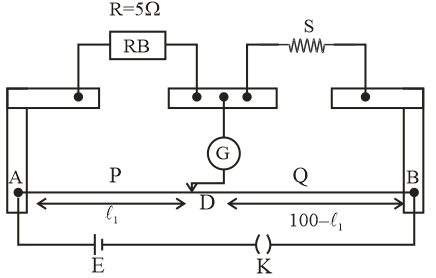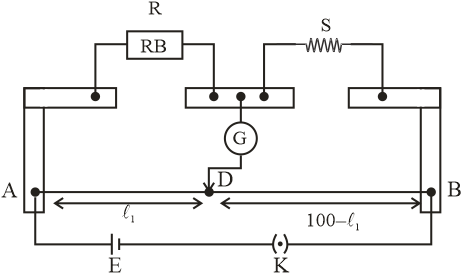Question
Question: What is the end error in meter bridge ? How to overcome it ? The resistances in two arms of meter br...
What is the end error in meter bridge ? How to overcome it ? The resistances in two arms of meter bridge are R=5Ω and S respectively when resistance S is shunted with equal resistance, the new balancing length found to be 1.5ℓ, where ℓ, is initial balancing length. Calculate value of S.

Solution
A meter bridge end error occurs due to shifting of zero. We will write the proper definition in the solution section. Here we can understand what is the end error in simple language.See, we need to stretch the 1m wire in between two clamps so, to fix the wire we will make a loop on both the sides around the clamping screw. So a little length of wire can be more or less on both sides.And now the effective lengths of the meter bridge can be </> 1 meter.

Complete step by step answer:
End error : The shifting of zero of the scale at different points as well as the stray resistance due to non-uniformity of metal wire gives rise to end error in meter bridge.
How to overcome and error
End error can be removed by repeating the experiment by interchanging unknown and known resistance and finally taking the mean value of resistance obtained in each experiment.
Now we will solve the second part of the given question.
It is given that resistance of two arms are R=5Ω and SΩ
By wheatstone bridge principle
SR=100−ℓ1ℓ1
Where ℓ1 and 100−ℓ1 are AD and DB respectively.
So, ℓ1R=100−ℓ1S …..(1)
After showing resistance S by equal resistance, the new balancing length is 1.5ℓ. Here shunting is connecting parallel resistance.
So, after shunting :
Now resistance, S′=S1+S1=S2
Or, S′=2S
It is given that now balancing length is 1.5ℓ1.
Using whether stone bridge principle, S′R=(100−ℓi)ℓi
Or, ℓiR=(100−ℓi)S′
Here, ℓ12=1.5ℓ1 S′=2S
So, 1.5ℓ1R=(100−1.5ℓ1)S/2
⇒ℓ1R=2(100−1.5ℓ1)1.5×S …..(2)
From equation (1) and (2)
⇒ℓ1R=100−ℓ1S=2(100−1.5ℓ1)1.5×S
⇒100−ℓ11=2(100−1.5ℓ1)1.5
⇒2(100−1.5ℓ1)=1.5(100−ℓ1)
⇒200−3.0ℓ1−150−1.5ℓ1
⇒50=1.5ℓ1
⇒ℓ1=1.550=15500
⇒ℓ1=3100cm …..(3)
By substituting value of ℓ1 from equation (3)
In equation (1) i.e., ℓ1R=(100−ℓ1)S
⇒(100/3)R=[100−3100]S
It is given that R=5Ω
⇒1005×3=(300−100)3S
⇒10015=2003S
⇒5=2S
⇒S=10Ω
Therefore the value of S is 10Ω.
Note: To get balancing length of meter bridge, deflection in galvanometer should be 0. Only then we can use the formula of wheatstone bridge.
